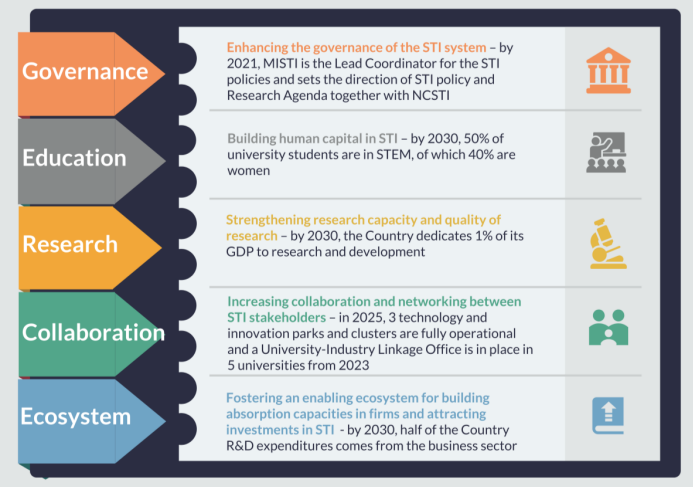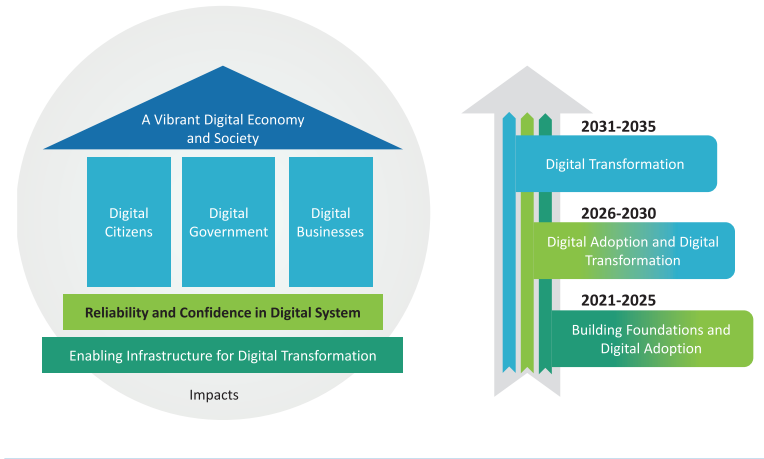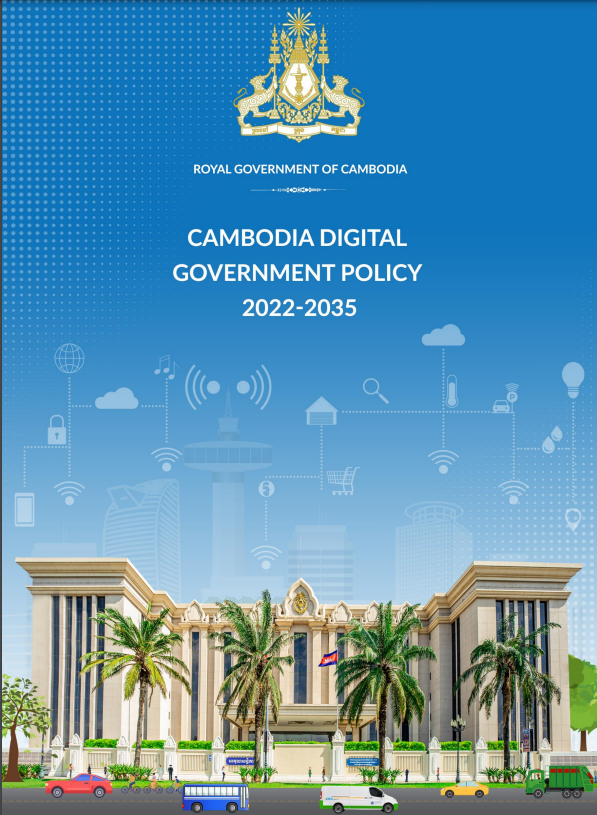Cambodia has the ambition to transform and digitalize the government system and its economy. The overarching determination comes after the country’s ambitious economic goal of 2050, the readiness to keep up with the region’s science and technology development, and the global megatrend, the fourth industrial revolution (IR 4.0).1 IR4.0 refers to the global development trend where technological advancement is at the core of the industrial landscape transformation of the world.2
In the 21st century, the advancement in science and technology has offered potential ambition to socio-economic development mainly due to its ability to accelerate productivity and the global shift toward the next industrial revolution.3 The blooming in technological innovation gave rise to the shift in the labour market from low and middle-skill to high-skill bases where technology and digital advancement bring about changes in economic drivers and a huge impact on individual daily life.4
Transitioning toward industrial 4.0 required a strong and resilient digital foundation and society. Fully recognizing the country’s setback, the Royal Government of Cambodia (RGC) has shown commendable efforts and commitment to integrated science and technology into core strategic sectors, including education, economy, governance, financial transaction, infrastructure development, and manufacturing.
The RGC has acknowledged the significance of science and tech in political, social, and economic development. As a result, the RGC has established the Ministry of Industry, Science, Technology, and Innovation (MISTI). The decision indicates a strong government’s focus and long-term vision of establishing a solid science and technology foundation. MISTI was established in 20205 and has the responsibilities of organizing, managing, promoting, supporting, and implementing policies, development programs, and innovative technology in industry science, technology, and innovation, including handicraft and potable water at national and sub-national levels. 6
Science and technology policies
Major Science and Technology national policies and strategic frameworks include:
- National Policy on Science, Technology and Innovation 2020-2030
- Science Technology and Innovation roadmap 2030 (STI roadmap 2030)
- Digital Economy and Social policy framework of Cambodia 2021-2035
- Digital Government Policy 2022-2035
National policy on science, technology and innovation 2020-2030
Aligned with Cambodia’s economic goal of 2050, this policy was established in 2019 and formulated by the National Council of Science and Technology. It is considered the main policy framework that guides other relevant ministries and institutions to take further action toward science, technology, and innovation. The main goal of this policy is to strengthen the fundamental of Science, Technology, and Innovation and establish an innovation ecosystem for sustainable development and ensure improvement in quality of life in every aspect and sector. The conceptual framework of this policy emphasizes the role of human capital development, innovative ecosystem, and research methodology to minimize the science and technology skill gap with other countries in the region.7 As mentioned in the policy, development in STI is interdisciplinary and high-skill-oriented that requires cooperation between relevant ministries and stakeholders. In the policy action plan, relevant national institutions should establish their own STI department to oversee, partake in, and improve science, technology, and innovative research aligned with each institution’s priority sector. Moreover, STI in the public services sector, such as Intellectual Property-related activities, national standards on certification, and technology competency, are encouraged to improve.
Science technology innovation roadmap 2030
STI roadmap 2030 is the national strategic framework that responds to the need to consolidate the STI foundation, enhance the digital ecosystem and develop an environment for sustainable development. The Ministry of Industry, Science, Technology and Innovation (MISTI) established the policy framework, emphasizing five main areas, including Governance, Education, Research, Collaboration, and Ecosystem.

Summary of the National Science, Technology and Innovation roadmap 2030. Source: Cambodia’s STI Roadmap 2030.
The roadmap seeks to realize its objectives by adapting and adopting existing and new technologies and endorsing new innovations. The five main pillars of STI roadmap 2030 are:
- Improving the governance of the national innovation system
- Building human capital in Science, Technology, and innovation
- Strengthening research capacities and the quality of research in public research institutions and universities
- Increasing the collaboration and networking between stakeholders within the national innovation system
- Fostering and enabling ecosystem for building absorptive capacities in firms and attracting investments in STI.
Digital economy and social policy framework 2021-2035
This policy framework aims to build a vibrant digital economy and society by laying the foundation for promoting digital adaptation and transformation in all sectors of society – the state, citizens, and businesses – to promote new economic growth and improve social welfare based on the new normal. Three principles have been implemented in this policy framework, namely, building a digital foundation, digital adoption, and transformation.8

Principles and framework for building Cambodia’s digital economy and society. Source: Digital Economy and Social Policy Framework 2021-2035.
The main goal of the Digital Economy and Social Policy Framework 2021-2035 are:
- Developing infrastructure: concentrated on developing the high-speed internet network, digital payment system, and logistic system for the digital socio-economic development process.
- Building reliability and confidence in the digital system: emphasize the importance of digital security by raising awareness and building a legal system.
- Building digital citizens: promoting digital leadership, mobilizing digital talents, and transforming human resources into driving forces.
- Building digital government: promoting digital public services, improving data-based governance
- Enabling digital businesses: encouraging enterprises, particularly SMEs, to adopt digital technologies and create a robust startup ecosystem.
Digital government policy 2022-2035
The ambition to establish a digital and smart government in Cambodia requires a well-built digital and innovative ecosystem that allows room for new technologies to operate at the national and sub-national levels. It involves the development of digital infrastructure and human capital to utilize and fully embrace the up to date technology. Strategy number 5 focuses on digital government and governance management, and one of its objectives is to implement Law on digital government. During the Digital Government Policy dissemination workshop, the draft law on digital government has been presented by the Under Secretary of State of the Ministry of Post and Telecommunication and the draft is currently in the development process.9 The draft law consists of 20 chapters that aim to regulate and cover all digital government and governance activities.10

Overview of Digital Government Policy Development of Cambodia 2022-2035. Source: Digital Government Policy 2022-2035.
Cambodia envisioned a smart government and accountable public service delivery system based on digital infrastructures. This national policy will modernize the governance system by setting out ten key strategies such as:
- Manage and enhance digital connection infrastructure
- Manage and enhance public service’s financial transaction infrastructure and system
- Manage and enhance digital security infrastructure
- Development of postal service infrastructure
- Manage digital government and governance
- Digital government transformation and public service delivery
- Establishment of digital human capital
- Promote research and digital innovation
- Initiate cooperation with technological and digital companies
- Promote new digital business
Challenges and way forward
To transform and digitalize the government, society and economy, the Royal Government of Cambodia must overcome various challenges and threats associated with adapting science and technology, including inclusive digital transformation, cyberattack, cybercrime and privacy protection.
Cyber security and privacy protection
Governments around the world have increasingly recognized the significance of cyber security in dealing with the setback of using advanced digital technologies.11 According to the United Kingdom IT governance, “Cyber security is the application of technologies, processes and controls to protect systems, networks, programs, devices and data from cyberattacks.”12 Cyber risks such as cyberattacks, cybercrime, online scam, fraud and data protection problems have been accelerating rapidly over the last few decades due to the growing adaptation of digital and new technologies.
The Cambodian government has experienced a few cyberattacks on official websites and hackers have leaked confidential information online.13 Citizens and businesses have usually reported online scams and fraud to authorities, which have cost them time and money. Moreover, hackers have also targeted several of Cambodia’s biggest internet services providers (ISPs) in the form of distributed denial-of-service (DDoS)14. It has caused major internet connectivity issues all over the country. These are some examples of the disruptive consequences of cyberattacks and how they can affect Cambodian’s day-to-day life.
The Cambodian government has strengthened its cyber governance framework by establishing various cybersecurity-related laws, regulations and authorities. Emergency Response Team (CamCERT) was established in 2007.15 CamCERT is responsible for providing information on computer security advice to all relevant stakeholders at risk of cyber-attack.16 It also acts as a computer emergency response team that provides a point of contact to deal with computer security incidents. The team has developed an early warning system on ICT security, researched new technologies, and managed National Security Center.17
The office of the Council of Ministers has established a working group in 2010 to work to draft the Law on cybercrime which is Cambodia’s primary legal document that deals with cyber-related issues. However, the law is still in the drafting process. Its controversial contents have provoked public reaction and fear that the Law may further suppress human rights and freedom of online speech in the country.18 In 2015, the Ministry of Post and Telecommunications issued a clarification in response to the concern that the draft law is still in its early stage of development and that the Law is intended to prevent and combat cybercrime by using law enforcement.19
Under the Ministry of Economy and Finance, the Cambodia Data Exchange Platform (CamDX) was created to deal with data and privacy protection in the digital-oriented society. It is an innovative platform that aims to expand startups in the country.20 CamDX provided a reliable and secured data exchange platform. According to its official website, CamDX ensures that data exchange between information systems and customer services is reliable and secured using standard technology and secure servers. It makes sure that data exchanges between customers are encrypted, which provides privacy and confidentiality. As of December 2021, there are 12,964 average daily transactions and approximately 10,147 businesses/enterprises registered on CamDX’s business registration platform.21
Inclusive digital transformation
During the digital transition period, complications with unequal digital access and the technology dividend may pose challenges for Cambodia’s government and society. The United Nations has established a framework of “a whole-of-society approach” for inclusive digital transformation based on four main principles: universality, responsibility, equality, and openness.22 Governments and policymakers should acquire the concept of this approach when formulating policies.23 The approach is based on the notion of digital inclusion that leaves no one behind and ensures equal digital access during the transformation.
According to UNDP Digital Transformation Expert, Cambodia needs to address the barrier of the digital divide first to achieve inclusive and smooth digital transformation.24 Examples of digital divide barriers are access to internet connection and wide gap in digital literacy.25 In 2021, there are 8.86 million people who access the internet, which is roughly 50% of the population.26 Internation Telecommunication Union (ITU) found out in 2017 that only 30% and 50% of households in rural and urban areas have internet access, respectively.27Moreover, Only 30% of the entire population obtained basic digital literacy that is able to use digital devices and platforms, said Minister of Post and Telecommunication, Chea Vandeth.28 This gap needed to be addressed in order to realize the government’s digital development vision, he added. 29.
Related to Science and technology policy and administration
References
- 1. Dirk Willem and et al, “Fostering an inclusive digital transformation in Cambodia,” ODI, July 2020, accessed April 2022.
- 2. Alejendro Lavopa and Michele Delera, “What is the fourth industrial revolution?,” January 2021, accessed April 2022.
- 3. ibid.
- 4. Steven Mckee and Danny Gauch, “Implication of Industry 4.0 on skill development,” Springer, November 2020, accessed April 2022.
- 5. Royal Government of Cambodia, “Law on the establishment of Ministry of Industry, Science, Technology and Innovation,” 2020, accessed April 2022.
- 6. Ministry of Industry, Science, Technology and Innovation, “About the Ministry,” accessed April 2022.
- 7. National Council of Science and Technology, “National Policy on Science, Technology and Innovation 2020-2030,” 2019, accessed April 2022.
- 8. National Economic Council, “Digital Economy and Social Policy Framework,” May 2021, accessed May 2022.
- 9. Kong Phallack, “Presentation on perspective on Cambodia Digital Government Law,” Digital Government Policy workshop, session 3, accessed April 2022.
- 11. Henrique Santos, “Cybersecurity Fundamentals,” April 2022, accessed May 2022.
- 12. United Kingdom IT governance, “What is Cybersecurity?,” accessed May 2022.
- 13. Somaly Ngoun and Sopheak Srun, “Cambodia v. Hackers: Balancing Security and Liberty in Cybercrime Law,” Konrad Adenauer Stiftung, January 2020, accessed May 2022.
- 14. Cambodia Development Resource, “Cybergovernance in Cambodia: A Risk-Based Approach to Cybersecurity Institution,” Special Report No.18, accessed May 2022.
- 15. Ou Phannarith, “Presentation on Cybersecurity,” Digital Government Policy workshop, Session 2, accessed May 2022.
- 16. ibid.
- 17. CamCERT, “what we do?,” accessed May 2022.
- 18. Gerald Flynn and Phuong Vantha, “Cambodia’s Online Freedoms under Threat from Draft Cybercrime Law,” Cambodianess, October 2020, accessed May 2022.
- 19. Ministry of Post and Telecommunication, “Clarification on the draft of Cybercrime law,” May 2015, accessed May 2022.
- 20. Marina Phal, “Cambodia Data Exchange,” KAS workshop, December 2021, accessed May 2022.
- 21. ibid.
- 22. Karina Grageda, “The Whole of Society Approach: Levels of engagement and meaningful participation of different stakeholders in the review process of the 2030 Agenda,” October 2018, accessed May 2022.
- 23. ibid.
- 24. Clare Curran, “Pathway to inclusive digital transformation,” Digital Government Policy workshop, Session 1, accessed May 2022.
- 25. Oxfam, “Bridging the digital divide in Cambodia,” accessed May 2022.
- 26. Simon Kemp, “Digital 2021: Cambodia,” February 2021, accessed May 2022.
- 27. ITU, “Digital Development Dashboard,” accessed May 2022.
- 28. Ngai Nai, “Cambodia lags in digital literacy,” kiripost, March 2022, accessed May 2022.
- 29. ibid.


